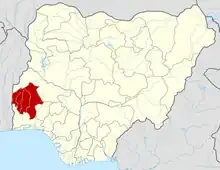The following is a timeline of the history of the city of Ibadan, Oyo State, Nigeria.
Prior to 20th century
| Part of a series on the | ||||||||||||||||||
| History of Nigeria | ||||||||||||||||||
|---|---|---|---|---|---|---|---|---|---|---|---|---|---|---|---|---|---|---|
 | ||||||||||||||||||
| Timeline | ||||||||||||||||||
|
||||||||||||||||||
| Topics | ||||||||||||||||||
| By state | ||||||||||||||||||
| See also | ||||||||||||||||||
|
| ||||||||||||||||||
20th century
- 1913 – Ibadan Grammar School established.
- 1916 – Moor Plantation established near Ibadan.[3]
- 1929 – Government College founded.
- 1947 – Economic protest.[4]
- 1948 – University College of Ibadan and its Botanical Garden established.[1][5]
- 1949 – Nigerian Tribune newspaper begins publication.[6]
- 1951 – Ibadan Peoples Party organized.
- 1952 – Population: 459,196.[7]
- 1954 – Nigerian Records Office headquartered in Ibadan.[8]
- 1955
- Historical Society of Nigeria founded in Ibadan.[9]
- Isaac Babalola Akinyele becomes Olubadan.
- 1957 – Black Orpheus literary magazine begins publication.[1][10]
- 1958 – Nigerian National Archives headquartered in city.[8]
- 1959 – Western Nigerian Government Broadcasting Corporation (WNTV) television begins broadcasting (later NTA Ibadan).[11]
- 1960
- Liberty Stadium opens.
- Nigerian Institute of Social and Economic Research headquartered in city.[12]
- 1961 – Mbari Writers and Artists Club formed.[10]
- 1962 – University of Ibadan active;[13] Institute of African Studies founded.[14]
- 1963 – Population: 627,380.[15]
- 1965 – Cocoa House built.
- 1967 – International Institute of Tropical Agriculture headquartered in city.
- 1975
- Population: 847,000.[16]
- David Jemibewon becomes governor of Oyo State.
- 1976
- 1982 – Leventis United football team formed.
- 1989 – Egbeda, Ido, and Ona Ara semi-urban local governments created.[17]
- 1991 – Ibadan North, Ibadan North-East, Ibadan North-West, Ibadan South-East, and Ibadan South-West urban local governments created.[17]
- 1999 – Yinusa Ogundipe Arapasowu I becomes Olubadan
21st century

View of Ibadan, 2016
- 2003
- Ibadan Internet Exchange commissioned.
- Rashidi Adewolu Ladoja becomes governor of Oyo State.
- 2007 – Oyekunle Ayinde Olukotun becomes Olubadan.
- 2011
- Abiola Ajimobi becomes governor of Oyo State.
- Population: 2,949,000 (urban agglomeration).[18]
See also
- Ibadan history
- List of Olubadan
- Timelines of other cities in Nigeria: Kano, Lagos, Port Harcourt
References
- 1 2 3 Toyin Falola; Ann Genova (2009). Historical Dictionary of Nigeria. Scarecrow Press. ISBN 978-0-8108-6316-3.
- ↑ "Hinderer, David, Nigeria, Anglican (CMS)". www.dacb.org. Archived from the original on 2011-09-16.
- ↑ Julius O. Ihonvbere; Timothy Shaw (1998). Illusions of Power: Nigeria in Transition. New Jersey, US: Africa World Press. ISBN 978-0-86543-642-8.
- ↑ Tom G. Forrest (1994). The Advance of African Capital: The Growth of Nigerian Private Enterprise. University of Virginia Press. ISBN 978-0-8139-1562-3.
- ↑ "Garden Search: Nigeria". London: Botanic Gardens Conservation International. Retrieved 30 August 2015.
- ↑ "Ibadan (Nigeria) – Newspapers". Global Resources Network. Chicago, US: Center for Research Libraries. Retrieved 30 September 2014.
- ↑ "Population of capital city and cities of 100,000 or more inhabitants". Demographic Yearbook 1955. New York: Statistical Office of the United Nations.
- 1 2 Toyin Falola; Saheed Aderinto (2010). Nigeria, Nationalism, and Writing History. University Rochester Press. ISBN 978-1-58046-358-4.
- ↑ Gloria Chuku, ed. (2013). "Kenneth Dike: the Father of Modern African Historiography". The Igbo Intellectual Tradition: Creative Conflict in African and African Diasporic Thought. Palgrave Macmillan. pp. 137–164. ISBN 978-1-137-31129-0.
- 1 2 "Guinea Coast, 1900 A.D.–present: Key Events". Heilbrunn Timeline of Art History. New York: Metropolitan Museum of Art. Retrieved 30 August 2015.
- ↑ Louise M. Bourgault (1995). Mass Media in Sub-Saharan Africa. Indiana University Press. ISBN 0-253-11309-1.
- ↑ "History of NISER". Government of Nigeria. Retrieved 30 September 2014.
- 1 2 Our History, Government of Oyo State, retrieved 30 August 2015
- ↑ Robert W. July (1987). "Chapter 9". An African Voice: The Role of the Humanities in African Independence. US: Duke University Press. p. 192+. ISBN 0-8223-0769-3.
- ↑ Udo 1970.
- ↑ United Nations Department of Economic and Social Affairs, Statistical Office (1976). "Population of capital city and cities of 100,000 and more inhabitants". Demographic Yearbook 1975. New York. pp. 253–279.
{{cite book}}: CS1 maint: location missing publisher (link) - 1 2 3 Detailed Information of the 33 Local Governments in Brief, Government of Oyo State, retrieved 30 August 2015
- ↑ The State of African Cities 2014. United Nations Human Settlements Programme. 10 September 2015. ISBN 978-92-1-132598-0. Archived from the original on 2014-09-10.
- This article incorporates information from the Yoruba Wikipedia.
Bibliography
- N.C. Mitchel (1953), "Some comments on the growth and character of Ibadan's population", Research Notes, University College of Ibadan, Department of Geography, no. 4
- C.G. Feilberg (1958), "Ibadan", Kulturgeografi, no. 10, pp. 77–91
- T. Oloko (Oct 1960), "A tale of 4 cities: Lagos, Ibadan, Kaduna and Enugu", Nigeria Magazine, pp. 137–147
- Akin L. Mabogunje (March 1961), "Ibadan black metropolis", Nigeria Magazine, no. 68, pp. 12–26
- Akin L. Mabogunje (1962), "Growth of residential districts in Ibadan", Geographical Review, vol. 52
- R.A. Akinola (1964), "Industrial structure of Ibadan", Nigerian Geographical Journal, vol. 7, ISSN 0029-0084
- Joel Bruce Splansky (1966), "Concentric zone of theory of city structure as applied to an African city: Ibadan, Nigeria", Yearbook of the Association of Pacific Coast Geographers
- R.A. Akinola (1967), "Problems of urban development in Nigeria-the example of Ibadan", Bulletin of Ghana Geographical Association, vol. 12, ISSN 0016-9536
- P.C. Lloyd; et al., eds. (1967), In the City of Ibadan: a symposium on its structure and development, London
{{citation}}: CS1 maint: location missing publisher (link) - G.A. van der Knapp (1967), "Lagos en Ibadan; een stadsgeographische vergelijking", Kroniek van Afrika (in Dutch), vol. 7, ISSN 0023-4893
- Muench and Muench (1968), "Planning and anticipating in Nigeria: Lagos and Ibadan", Journal of the American Institute of Planners, vol. 34
- G.A. Onibokun (1969), "Socio-cultural constraints on urban renewal policies in emerging nations: the Ibadan case", Nigerian journal of economic and social studies, vol. 11
- G.A. Onibokun (1970), "Nigerian cities: their rehabilitation and redevelopment (Ibadan case study)", African Studies Review, vol. 13
- Reuben K. Udo (1970). "Ibadan". Geographical Regions of Nigeria. University of California Press. p. 34+.
- H.I. Ajaegbu (1971), Forms of under-integrated urban growth: the case of the old residential quarters in Ibadan, Nigeria, Paris: Secretariat de Missions d’Urbanisme et d’habitat
- J.O. Oyelese (1971), "Growth of Ibadan city and its impact on land-use patterns, 1961–65", Journal of Tropical Geography, vol. 14
- Wole Soyinka (1994). Ibadan: The 'Penkelemes' Years, A Memoir, 1946–1965. Methuen. ISBN 0413686701.
- Simon Heap (1997), "'Jaguda Boys': Pickpocketing in Ibadan, 1930–60", Urban History, vol. 24, no. 3, pp. 324–343
- Ruth Watson (2003). 'Civil Disorder is the Disease of Ibadan': Chieftaincy and Civic Culture in a Yoruba City. Oxford: James Currey. ISBN 0-85255-454-0.
- "Ibadan". Understanding Slums: Case Studies for the Global Report 2003. United Nations Human Settlements Programme and University College London. 2003.
- Paul Tiyambe Zeleza; Dickson Eyoh, eds. (2003). "Ibadan, Nigeria". Encyclopedia of Twentieth-Century African History. Routledge. ISBN 0415234794.
- Kevin Shillington, ed. (2005). "Ibadan". Encyclopedia of African History. Fitzroy Dearborn. ISBN 978-1-57958-245-6.
External links
Wikimedia Commons has media related to Ibadan.
- "(Ibadan)". Directory of Open Access Journals. UK. (Bibliography of open access
 articles)
articles) - "(Ibadan)" – via Europeana. (Images, etc.)
- "(Ibadan)" – via Digital Public Library of America. (Images, etc.)
- "(Ibadan)". Internet Library Sub-Saharan Africa. Germany: Frankfurt University Library. (Bibliography)
- "(Ibadan)". Connecting-Africa. Leiden, Netherlands: African Studies Centre. (Bibliography)
- "(Ibadan)". AfricaBib.org. (Bibliography)
- "Ibadan, Nigeria". BlackPast.org. US. 8 March 2011.
- "Nigeria: Ibadan". ArchNet. Archived from the original on 25 February 2006.
This article is issued from Wikipedia. The text is licensed under Creative Commons - Attribution - Sharealike. Additional terms may apply for the media files.
